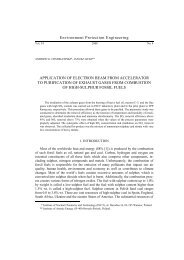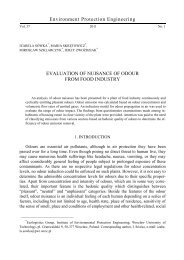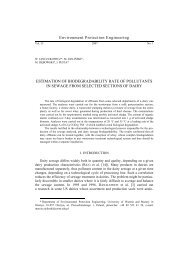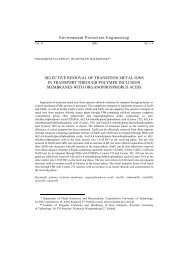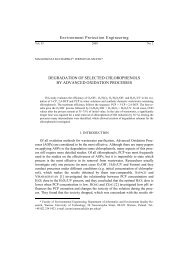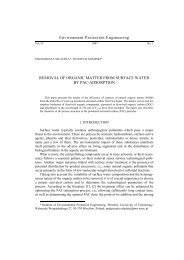pH effect on decolorization of raw textile wastewater polluted with ...
pH effect on decolorization of raw textile wastewater polluted with ...
pH effect on decolorization of raw textile wastewater polluted with ...
Create successful ePaper yourself
Turn your PDF publications into a flip-book with our unique Google optimized e-Paper software.
Envir<strong>on</strong>ment Protecti<strong>on</strong> Engineering<br />
Vol. 35 2009 No. 3<br />
JUSTINA RACYTE* , ***, MINDAUGAS RIMEIKA*, HARRY BRUNING**<br />
<str<strong>on</strong>g>pH</str<strong>on</strong>g> EFFECT ON DECOLORIZATION OF<br />
RAW TEXTILE WASTEWATER POLLUTED WITH<br />
REACTIVE DYES BY ADVANCED OXIDATION WITH UV/H2O2<br />
The <str<strong>on</strong>g>effect</str<strong>on</strong>g>iveness <strong>of</strong> the advanced oxidati<strong>on</strong> process (UV/H 2O 2) in decolorizing real <strong>textile</strong><br />
<strong>wastewater</strong> <strong>polluted</strong> <strong>with</strong> commercial reactive dyes – Reactive Yellow 84 and Reactive Red 141 –<br />
was investigated. All the experiments were performed in a lab-scale reactor <strong>with</strong> the original high <str<strong>on</strong>g>pH</str<strong>on</strong>g><br />
<strong>of</strong> the <strong>wastewater</strong>. The dyeing <strong>wastewater</strong> was decolorized in 5 hours. After its acidificati<strong>on</strong> to <str<strong>on</strong>g>pH</str<strong>on</strong>g> 3<br />
the decolorizati<strong>on</strong> process was more efficient. Full decolorizati<strong>on</strong> was then achieved in 2 hours and<br />
the decrease in COD exceeded 70%. The reacti<strong>on</strong> rate c<strong>on</strong>stants obtained were as follows: at <str<strong>on</strong>g>pH</str<strong>on</strong>g><br />
11.4, 0.0065 min –1 ; at <str<strong>on</strong>g>pH</str<strong>on</strong>g> 7, 0.0044 min –1 , and at <str<strong>on</strong>g>pH</str<strong>on</strong>g> 3, 0.019 min –1 , which testified to <str<strong>on</strong>g>pH</str<strong>on</strong>g> importance<br />
for UV/H 2O 2 oxidati<strong>on</strong> process.<br />
1. INTRODUCTION<br />
Reactive dyes, though being envir<strong>on</strong>mentally hazardous and possibly carcinogenic,<br />
are used extensively due to their excellent wash fastness. The amount <strong>of</strong> cott<strong>on</strong><br />
dyes is 50% <strong>of</strong> all dyes c<strong>on</strong>sumpti<strong>on</strong> in the world (BLACKBURN et al. 2002). Reactive<br />
dyeing has been the most comm<strong>on</strong> method for cott<strong>on</strong> dyeing in the past years<br />
(RAJKUMAR et al. 2006, ROESSLER et al. 2003). The use <strong>of</strong> reactive dyes is steadily<br />
increasing because <strong>of</strong> their simple dyeing procedure and good stability during washing<br />
process (KUSIC et al. 2006). Reactive dyes bind not <strong>on</strong>ly to fabric but also react<br />
<strong>with</strong> water, because <strong>of</strong> wash fastness (BLACKBURN et al. 2002). Therefore, 30–50% <strong>of</strong><br />
the reactive dyes applied in the <strong>textile</strong> industry are washed out after the dyeing process<br />
(BLACKBURN et al. 2002, OLIVER et al. 1999, KURBUS et al. 2003). When reactive<br />
dyeing <strong>wastewater</strong> is discharged <strong>with</strong>out appropriate treatment to the c<strong>on</strong>venti<strong>on</strong>al<br />
public treatment plants, 90% <strong>of</strong> dyes present in the <strong>wastewater</strong> pass to the surface<br />
waters (OLIVER et al. 1999).<br />
* Department <strong>of</strong> Water Management, Vilnius Gediminas Technical University, Lithuania.<br />
** Sub-Department <strong>of</strong> Envir<strong>on</strong>mental Technology, Wageningen University, The Netherlands.<br />
*** Corresp<strong>on</strong>ding author: e-mail: Justina.Racyte@ap.vgtu.lt, Sauletekio al. 11, LT-10223 Vilnius, Lithuania.
168<br />
J. RACYTE et al.<br />
According to OLIVER et al. (1999) and MURUGANANDHAM et al. (2006) reactive<br />
dyes are toxic and carcinogenic to aquatic envir<strong>on</strong>ments, and in surface waters inhibit<br />
light penetrati<strong>on</strong> and minimize photosynthesis. Reactive dyes are characterized as<br />
hard biologically degradable substances, and biological treatment methods for dyeing<br />
<strong>wastewater</strong> could be employed partly, but not as a main treatment process (OLIVER et<br />
al. 1999, AZBAR et al. 2004, ALATON et al. 2001). Therefore much attenti<strong>on</strong> is given<br />
to physical and chemical treatment methods that have been successfully tested for<br />
neutralizati<strong>on</strong> <strong>of</strong> reactive dyeing <strong>wastewater</strong>s (OLIVER et al. 1999, KURBUS et al.<br />
2003, MURUGANANDHAM et al. 2006, AZBAR et al. 2004, ALATON et al. 2001).<br />
Some <strong>of</strong> the methods, e.g. Fent<strong>on</strong>’s method and c<strong>on</strong>venti<strong>on</strong>al filtrati<strong>on</strong> methods,<br />
are not suitable for <strong>textile</strong> <strong>wastewater</strong> treatment from sustainability point <strong>of</strong> view,<br />
because toxic sludge is produced resulting in sludge disposal problems<br />
(NTAMPEGLIOTIS et al. 2006, GULTEKIN et al. 2004, ARSLAN et al. 2000). C<strong>on</strong>siderable<br />
attenti<strong>on</strong> has been paid to Advanced Oxidati<strong>on</strong> Processes (AOP) in the past decade.<br />
The main mechanism <strong>of</strong> AOP is based <strong>on</strong> active hydroxide radical (•OH) formati<strong>on</strong>.<br />
Radicals are formed under UV light employing hydrogen peroxide (H2O2), oz<strong>on</strong>e<br />
(O3), and in some cases a photo-catalyst: titanium dioxide (TiO2) (FELIS et al. 2008,<br />
MURUGANANDHAM et al. 2006, ALATON et al. 2002). UV/H2O2 method applicati<strong>on</strong> <strong>on</strong><br />
<strong>textile</strong> <strong>wastewater</strong> has some undefined issues, such as the optimal <str<strong>on</strong>g>pH</str<strong>on</strong>g>. The <str<strong>on</strong>g>pH</str<strong>on</strong>g> range<br />
can str<strong>on</strong>gly affect the decolorizati<strong>on</strong> efficiency and reacti<strong>on</strong> rate. Several opini<strong>on</strong>s <strong>of</strong><br />
<str<strong>on</strong>g>pH</str<strong>on</strong>g> importance and optimal value are stated in literature (OLIVER et al. 1999,<br />
GULTEKIN et al. 2004, ALATON et al. 2002), where the optimal process <str<strong>on</strong>g>pH</str<strong>on</strong>g> value varies<br />
from 11 to 3.<br />
Most <strong>of</strong> the AOP studies refer to artificially <strong>polluted</strong> water c<strong>on</strong>taining <strong>on</strong>e dye or<br />
a group <strong>of</strong> dyes (INCE et al. 2002, GALINDO et al. 1998, KUSVURAN et al. 2005). Only<br />
very few cases <strong>on</strong> successful AOP applicati<strong>on</strong> <strong>on</strong> real <strong>textile</strong> industry <strong>wastewater</strong><br />
treatment are published (OLIVER et al. 1999, SHU et al. 2006). Real <strong>textile</strong> <strong>wastewater</strong><br />
treatment is complicated because <strong>of</strong> extremely varying compositi<strong>on</strong> and high <str<strong>on</strong>g>pH</str<strong>on</strong>g> and<br />
COD values. Substantial amount <strong>of</strong> chemicals like NaCl, Na2SO4, NaOH, Na2CO3 and<br />
surfactants are added to the dyeing process, to improve the reactivity <strong>of</strong> the dyes.<br />
Chemicals added have extra load to <strong>wastewater</strong> polluti<strong>on</strong> and are also resp<strong>on</strong>sible for<br />
a high COD and <str<strong>on</strong>g>pH</str<strong>on</strong>g> level <strong>of</strong> the <strong>wastewater</strong> (KURBUS et al. 2003). Also, these chemicals<br />
are used to keep a <str<strong>on</strong>g>pH</str<strong>on</strong>g> c<strong>on</strong>stant during the dyeing process, necessary to improve<br />
−<br />
2−<br />
the reactive dye b<strong>on</strong>ding to the fabric. The ani<strong>on</strong>s Cl and CO 3 are both stated as<br />
•OH radical scavengers and remain after the dyeing bath in the <strong>wastewater</strong>. The presence<br />
<strong>of</strong> scavengers has a great negative influence for UV/H2O2 – AOP performance<br />
(OLIVER et al. 1999, MURUGANANDHAM et al. 2006, AZBAR et al. 2004, ALATON<br />
et al. 2001, SHU et al. 2006, GALINDO et al. 1998).<br />
The purpose <strong>of</strong> the study is to determine the applicability <strong>of</strong> UV/H2O2 advanced<br />
oxidati<strong>on</strong> method for the removal <strong>of</strong> reactive dye from reactive dyeing <strong>raw</strong> <strong>wastewater</strong><br />
and to define the influencing factors.
<str<strong>on</strong>g>pH</str<strong>on</strong>g> <str<strong>on</strong>g>effect</str<strong>on</strong>g> <strong>on</strong> decolorizati<strong>on</strong> <strong>of</strong> <strong>raw</strong> <strong>textile</strong> <strong>wastewater</strong> 169<br />
To gain more informati<strong>on</strong> about the UV/H2O2 method, the <str<strong>on</strong>g>pH</str<strong>on</strong>g> influence was investigated<br />
in this work. Two types <strong>of</strong> <strong>textile</strong> reactive dyeing <strong>raw</strong> <strong>wastewater</strong>s obtained<br />
from industry were examined in the lab – scale UV/H2O2 reactor. For investigati<strong>on</strong> <strong>of</strong><br />
the <str<strong>on</strong>g>pH</str<strong>on</strong>g> impact <strong>on</strong> UV/H2O2 – AOP kinetics, the <str<strong>on</strong>g>pH</str<strong>on</strong>g> dependency <strong>on</strong> the decolorizati<strong>on</strong><br />
reacti<strong>on</strong> rate was examined. Oxidati<strong>on</strong> performance was investigated by applying an<br />
ordinary UV/H2O2 method at original <strong>textile</strong> reactive dyeing <strong>wastewater</strong> <str<strong>on</strong>g>pH</str<strong>on</strong>g>, which is<br />
~11. Based <strong>on</strong> the buffer capacity <strong>of</strong> the <strong>wastewater</strong>, two lower <str<strong>on</strong>g>pH</str<strong>on</strong>g> values were chosen<br />
to perform an oxidati<strong>on</strong> experiment in the UV/H2O2 reactor.<br />
2. MATERIALS AND METHODS<br />
2.1. MATERIALS<br />
Hydrogen peroxide 30% (w/w) from Merck, Germany was used. Raw <strong>textile</strong><br />
<strong>wastewater</strong> was obtained in The Netherlands from a small scale <strong>textile</strong> industry,<br />
which dyes cott<strong>on</strong> yarn and pieces <strong>of</strong> cott<strong>on</strong> fabric. The producti<strong>on</strong> rate is approx. 500<br />
t<strong>on</strong>s <strong>of</strong> dyed yarn per year, and 60 000 m 3 <strong>of</strong> <strong>wastewater</strong> is produced per year. The<br />
<strong>wastewater</strong> (compositi<strong>on</strong> presented in Table 1) was taken from the reactive dyeing<br />
equipment prior to the rinsing stage. Two different colors reactive dyeing <strong>wastewater</strong><br />
samples for the investigati<strong>on</strong> <strong>of</strong> the UV/H2O2 – AOP performance were used: red<br />
color that c<strong>on</strong>tains 86% <strong>of</strong> reactive red 141 Color Index, 1976 (further in the text<br />
TYPE 1), and yellow color that c<strong>on</strong>tains 92% <strong>of</strong> reactive yellow 84 Color Index, 1976<br />
(further in the text TYPE 2). The <strong>wastewater</strong> samples were stored in plastic impenetrable<br />
tanks that were kept at +4 °C. Each experiment was repeated at least 3 times.<br />
The average <strong>of</strong> the values obtained was taken; data c<strong>on</strong>fidence interval is 97%.<br />
Wastewater<br />
samples<br />
Wastewater<br />
type<br />
<str<strong>on</strong>g>pH</str<strong>on</strong>g><br />
level<br />
Dyeing <strong>wastewater</strong> average compositi<strong>on</strong><br />
COD<br />
(mgO 2/dm 3 )<br />
Cl –<br />
(mg/dm 3 )<br />
Dye<br />
c<strong>on</strong>centrati<strong>on</strong><br />
in sample<br />
(mg/dm 3 )<br />
Wavelength<br />
(nm)<br />
Table 1<br />
Absorpti<strong>on</strong><br />
units<br />
(Abs)<br />
1. RR141 11.09 8664 51360 55.6 418 0.35<br />
2. RY84 11.23 10120 42468 62.3 430 0.42<br />
2.2. EQUIPMENT SETUP<br />
A schematic representati<strong>on</strong> <strong>of</strong> the experimental lab – scale UV/H2O2 reactor is<br />
presented in Figure 1. A reacti<strong>on</strong> vessel <strong>of</strong> 800 ml, made <strong>of</strong> quartz glass, was placed
170<br />
J. RACYTE et al.<br />
into a stainless steel hexag<strong>on</strong>al reflector <strong>with</strong> 6 UV – C light lamps (type – low pressure<br />
lamps maximum emissi<strong>on</strong> at 253.7 nm, 15 W each, length <strong>of</strong> lamp 0.41 m; Philips,<br />
The Netherlands). UV lamps were situated in a circular arrangement as shown in<br />
Figure 1 (A-A). The irradiati<strong>on</strong> power in the reactor was calculated according formulas<br />
proposed by MASSCHELEIN (2002). Temperature was maintained c<strong>on</strong>stant at 20 °C<br />
±2 as it influences the reacti<strong>on</strong> kinetics (NTAMPEGLIOTIS et al. 2006). <str<strong>on</strong>g>pH</str<strong>on</strong>g> was m<strong>on</strong>itored<br />
throughout the experiment <strong>with</strong> a <str<strong>on</strong>g>pH</str<strong>on</strong>g> meter – MT28-280-001 (<str<strong>on</strong>g>pH</str<strong>on</strong>g> electrode<br />
WTW Sen Tix 21, The Netherlands). For c<strong>on</strong>tinuous m<strong>on</strong>itoring <strong>of</strong> the dye c<strong>on</strong>centrati<strong>on</strong>,<br />
the reactor was c<strong>on</strong>nected to a peristaltic pump (Wats<strong>on</strong>–Marlow 302, The<br />
Netherlands) pumping the <strong>wastewater</strong> through the UV/Vis spectrophotometer cuvette.<br />
The spectrophotometric color intensity (absorpti<strong>on</strong>) was measured <strong>with</strong> Varian Cary<br />
3E UV-Vis Spectrophotometer (Varian B.V., The Netherlands). The absorpti<strong>on</strong><br />
measured was in range below 1 absorpti<strong>on</strong> units (Abs). Therefore, diluti<strong>on</strong> was not<br />
performed and change in color intensity could be measured <strong>on</strong>line. Spectrophotometer<br />
was c<strong>on</strong>nected to a computer and data was recorded at 1–10 minutes time intervals.<br />
1<br />
9<br />
1<br />
1 – Low pressure UV – C lamps; 2 – Quartz glass reacti<strong>on</strong><br />
vessel; 3 – Stainless steel hexag<strong>on</strong>al reflector; 4 –<br />
Thermometer; 5 – <str<strong>on</strong>g>pH</str<strong>on</strong>g> meter; 6 – Heat-exchanger; 7 –<br />
Sampler/H 2O 2infuser; 8 – Peristaltic pump; 9 – Kuvetes (a –<br />
blanc, other for sample); 10 – Spectrophotometer CV; 11 –<br />
Computer recording data <strong>on</strong>-line from spectrophotometer.<br />
A – A<br />
a<br />
8<br />
4<br />
7<br />
<str<strong>on</strong>g>pH</str<strong>on</strong>g><br />
meter<br />
1 1<br />
A A<br />
1 – Low pressure UV – C lamps;<br />
2 – Quartz glass reacti<strong>on</strong> vessel;<br />
3– Stainless steel hexag<strong>on</strong>al reflector.<br />
Fig. 1. Schematic representati<strong>on</strong> <strong>of</strong> experimental lab- scale UV/H 2O 2 reactor<br />
6<br />
2<br />
3
<str<strong>on</strong>g>pH</str<strong>on</strong>g> <str<strong>on</strong>g>effect</str<strong>on</strong>g> <strong>on</strong> decolorizati<strong>on</strong> <strong>of</strong> <strong>raw</strong> <strong>textile</strong> <strong>wastewater</strong> 171<br />
The reactor was filled <strong>with</strong> 800 ml <strong>of</strong> <strong>wastewater</strong> and 5 ml <strong>of</strong> 30% H2O2 soluti<strong>on</strong><br />
was added. The soluti<strong>on</strong> was irradiated until a steady value <strong>of</strong> absorpti<strong>on</strong> was observed<br />
<strong>with</strong> the spectrophotometer. The <strong>wastewater</strong> during the decolorizati<strong>on</strong> process<br />
was mixed hydraulically in 15 minutes time intervals in order to get better light penetrati<strong>on</strong><br />
in the depth <strong>of</strong> the reacti<strong>on</strong> vessel. During mixing, there was no c<strong>on</strong>tact <strong>with</strong><br />
oxygen.<br />
2.3. ANALYTICAL PROCEDURES<br />
Exact H2O2 amount c<strong>on</strong>sumed during the oxidati<strong>on</strong> was defined by means <strong>of</strong> determining<br />
residual (unreacted) H2O2 amount after each experiment by “Nanocolor<br />
Peroxid 2” (MACHEREY–NAGEL GmbH & Co, Germany).<br />
The decolorizati<strong>on</strong> due to the oxidati<strong>on</strong> was m<strong>on</strong>itored <strong>with</strong> the UV-Vis spectrophotometer<br />
(Carry Varian). The wavelength for measuring the oxidati<strong>on</strong> absorpti<strong>on</strong><br />
change was set analytically <strong>with</strong> the UV-Vis spectrophotometer. The maximal absorpti<strong>on</strong><br />
value (Abs) <strong>of</strong> each <strong>wastewater</strong> sample was defined by scanning the <strong>wastewater</strong><br />
sample in the range 200–800 nm. Maximal peaks obtained in the range have<br />
been assumed as characteristic values for measurement and were used for UV/H2O2 –<br />
AOP performance observati<strong>on</strong>. The highest signal measured was used to obtain the<br />
highest sensitivity <strong>of</strong> measurement. The wavelength (nm) at which the peaks for each<br />
type <strong>of</strong> dyes were obtained are given in Table 1.<br />
Dye c<strong>on</strong>centrati<strong>on</strong> was estimated from the absorbance unit and are compared and<br />
presented as percentage <strong>of</strong> initial c<strong>on</strong>centrati<strong>on</strong>. The initial c<strong>on</strong>centrati<strong>on</strong>s <strong>of</strong> dyes in<br />
different <strong>wastewater</strong> samples were different, therefore initial dye c<strong>on</strong>centrati<strong>on</strong>s were<br />
taken as 100%, and the demineralised water was used as blank sample (demineralised<br />
water c<strong>on</strong>ductivity below 0.5 µS/cm at 20 °C) was assumed as 0% <strong>of</strong> dye c<strong>on</strong>centrati<strong>on</strong>.<br />
The buffer capacity titrati<strong>on</strong> curves <strong>of</strong> the <strong>wastewater</strong> samples were obtained by<br />
titrating the <strong>wastewater</strong> samples <strong>with</strong> 1 N sulphuric acid and from measured redox<br />
potential the <str<strong>on</strong>g>pH</str<strong>on</strong>g> values were defined graphically. The sulphuric acid was chosen as<br />
a str<strong>on</strong>g acid for <str<strong>on</strong>g>pH</str<strong>on</strong>g> adjustment as it does not scavenge hydroxyl radicals and does not<br />
interfere in the spectrophotometric measurement.<br />
The COD <strong>of</strong> <strong>wastewater</strong> samples was determined by the Dr Lange COD test, before<br />
and after the UV/H2O2 method applicati<strong>on</strong>. The COD decrease was obtained by<br />
subtracti<strong>on</strong> from initial measured <strong>raw</strong> <strong>wastewater</strong> value the effluent measured value.<br />
As in <strong>wastewater</strong> was present high c<strong>on</strong>centrati<strong>on</strong> <strong>of</strong> Cl - i<strong>on</strong>s and after treatment –<br />
H2O2. In this case these two compounds interfere <strong>with</strong> the COD measurement; therefore,<br />
the <str<strong>on</strong>g>effect</str<strong>on</strong>g> <strong>on</strong> the measurement was quantified according methodology given in<br />
the literature (APHA 1995, KANG et al. 1998).
172<br />
J. RACYTE et al.<br />
3. RESULTS AND DISCUSSION<br />
3.1. TEXTILE REAL DYEING WASTEWATER DECOLORIZATION<br />
The decolorizati<strong>on</strong> under UV/H2O2 <strong>of</strong> two types <strong>of</strong> <strong>raw</strong> reactive dyeing <strong>wastewater</strong><br />
was carried out to define which <strong>of</strong> the two types <strong>of</strong> dyes is more receptive to decompositi<strong>on</strong><br />
(Figure 2).<br />
Wastewater<br />
type<br />
Dye c<strong>on</strong>centrati<strong>on</strong> decrease (%)<br />
100<br />
80<br />
60<br />
40<br />
20<br />
I<br />
0<br />
0 50 100 150 200 250 300<br />
II<br />
Irradiati<strong>on</strong> time (min)<br />
TYPE1<br />
TYPE2<br />
TYPE 1 start __<br />
TYPE 2 start . . .<br />
TYPE 1,2 end - -<br />
Fig. 2. Real dyeing <strong>wastewater</strong> decolorizati<strong>on</strong> process<br />
Real dyeing <strong>wastewater</strong> decolorizati<strong>on</strong> process characteristics<br />
Average <str<strong>on</strong>g>pH</str<strong>on</strong>g> during<br />
decolorizati<strong>on</strong><br />
process<br />
Average H2O2 amount<br />
used for decolorizati<strong>on</strong><br />
(mg/dm 3 )<br />
III<br />
Average COD<br />
removal (%)<br />
Table 2<br />
Average rate<br />
c<strong>on</strong>stant k'<br />
(min –1 )<br />
1 11.33 1531 64 0.00603<br />
2 11.47 2088 75 0.00716<br />
Decolorizati<strong>on</strong> <strong>of</strong> the <strong>wastewater</strong> TYPE 1 under UV/H2O2 – AOP started <strong>with</strong><br />
a slow reacti<strong>on</strong> period <strong>of</strong> 140 minutes. During this period <strong>of</strong> time 25% <strong>of</strong> dye residuals<br />
in <strong>wastewater</strong> was decomposed. During the next 60 minutes ~ 50% <strong>of</strong> dye residuals<br />
was decomposed (totally 75% dye decompositi<strong>on</strong> after 200 minutes was<br />
achieved). The same tendency could be observed <strong>with</strong> <strong>wastewater</strong> TYPE 2. The increase<br />
in decolorizati<strong>on</strong> begun after 180 minutes, and 75% dye decompositi<strong>on</strong> in<br />
<strong>wastewater</strong> was reached after 240 minutes. Decompositi<strong>on</strong> <strong>of</strong> dyes present in waste-
<str<strong>on</strong>g>pH</str<strong>on</strong>g> <str<strong>on</strong>g>effect</str<strong>on</strong>g> <strong>on</strong> decolorizati<strong>on</strong> <strong>of</strong> <strong>raw</strong> <strong>textile</strong> <strong>wastewater</strong> 173<br />
waters TYPE 1 and TYPE 2 was initially slow <strong>with</strong> 140 and 180 minutes lag time<br />
respectively (this inefficient stage in the graphical expressi<strong>on</strong> is marked as stage I in<br />
Figure 2). Apparently, the process starts <strong>with</strong> oxidati<strong>on</strong> <strong>of</strong> more easily degradable<br />
substances <strong>with</strong>out decolorisati<strong>on</strong>. After stage I has finished, the main fracti<strong>on</strong> <strong>of</strong> dye<br />
residual in both real <strong>wastewater</strong> samples were decomposed <strong>with</strong>in 100 minutes. This<br />
stage is called the useful UV/H2O2 – AOP stage and is marked as stage II in Figure 2.<br />
After about 220 minutes for both real <strong>wastewater</strong>s, dye decompositi<strong>on</strong> reacti<strong>on</strong>s<br />
slowed down, and during 80 minutes <strong>of</strong> oxidati<strong>on</strong> <strong>on</strong>ly 20% <strong>of</strong> dye residual was removed<br />
from the <strong>wastewater</strong>. This is marked as stage III in Figure 2.<br />
During 3 hours <strong>of</strong> oxidati<strong>on</strong>, ≥60% dye removal was obtained, and after 5 hours 80%<br />
<strong>of</strong> dye removal was obtained. The average amount <strong>of</strong> H2O2 c<strong>on</strong>sumed was 1810 mg/dm 3<br />
during 5 hours applicati<strong>on</strong> <strong>of</strong> UV/H2O2 – AOP.<br />
Though the main goal was dye decompositi<strong>on</strong>, also COD was degraded. The COD<br />
decrease during 5 hours reached 64% and 75% for TYPE 1 and TYPE 2 respectively<br />
(Table 2). The obtained UV/H2O2 – AOP applicati<strong>on</strong> results is similar as described by<br />
AZBAR et al. 2004, ALATON et al. 2001, ARSLAN et al. 2000, INCE et al. 2002.<br />
3.2. <str<strong>on</strong>g>pH</str<strong>on</strong>g> INFLUENCE FOR DECOLORIZATION UV/H 2O 2 – AOP<br />
A Na2CO3 – NaOH buffer is applied for stabilisati<strong>on</strong> <strong>of</strong> <str<strong>on</strong>g>pH</str<strong>on</strong>g> level in the dyeing process<br />
in industry. Buffer capacity was tested to examine the <str<strong>on</strong>g>pH</str<strong>on</strong>g> characteristics <strong>of</strong> the<br />
<strong>wastewater</strong>. To reduce the original <str<strong>on</strong>g>pH</str<strong>on</strong>g> <strong>of</strong> the reactive dyeing <strong>textile</strong> <strong>wastewater</strong> (Figure 3)<br />
1N sulphuric acid was added. The <str<strong>on</strong>g>pH</str<strong>on</strong>g> was reduced in the soluti<strong>on</strong> to reach stable <str<strong>on</strong>g>pH</str<strong>on</strong>g><br />
intervals, as could be observed from the graph presented in Figure 3. These stable <str<strong>on</strong>g>pH</str<strong>on</strong>g><br />
intervals are at: 11.4–11 (original <str<strong>on</strong>g>pH</str<strong>on</strong>g> <strong>of</strong> the <strong>wastewater</strong>); 7.5–6.5 and <str<strong>on</strong>g>pH</str<strong>on</strong>g> 3.5–2. At these<br />
<str<strong>on</strong>g>pH</str<strong>on</strong>g> intervals, the influence <strong>of</strong> <str<strong>on</strong>g>pH</str<strong>on</strong>g> <strong>on</strong> the UV/H2O2 oxidati<strong>on</strong> process was investigated.<br />
E (mV)<br />
300<br />
200<br />
100<br />
0<br />
-100<br />
-200<br />
-300<br />
5 10 15<br />
Amount <strong>of</strong> H 2SO4 (mg/L)<br />
Fig. 3. <str<strong>on</strong>g>pH</str<strong>on</strong>g> and redox potential as functi<strong>on</strong> <strong>of</strong> sulphuric acid added<br />
E<br />
<str<strong>on</strong>g>pH</str<strong>on</strong>g><br />
12<br />
11<br />
10<br />
9<br />
8<br />
7<br />
6<br />
5<br />
4<br />
3<br />
2<br />
<str<strong>on</strong>g>pH</str<strong>on</strong>g>
174<br />
J. RACYTE et al.<br />
According to KUSIC et al. 2006 and MALIK et al. 2004, the <str<strong>on</strong>g>pH</str<strong>on</strong>g> has a large impact<br />
<strong>on</strong> UV/H2O2 – AOP kinetics. Therefore, the <str<strong>on</strong>g>pH</str<strong>on</strong>g> influence <strong>on</strong> the kinetics for <strong>wastewater</strong><br />
TYPE 1 was investigated.<br />
Dye c<strong>on</strong>centrati<strong>on</strong> decrease (%)<br />
100<br />
80<br />
60<br />
40<br />
20<br />
<str<strong>on</strong>g>pH</str<strong>on</strong>g> 11.4<br />
<str<strong>on</strong>g>pH</str<strong>on</strong>g> 7<br />
<str<strong>on</strong>g>pH</str<strong>on</strong>g> 3<br />
0<br />
0 20 40 60 80 100 120<br />
Irradiati<strong>on</strong> time (min)<br />
Fig. 4. <str<strong>on</strong>g>pH</str<strong>on</strong>g> influence <strong>on</strong> the decolorizati<strong>on</strong> rate <strong>of</strong> <strong>textile</strong> dyeing <strong>wastewater</strong> TYPE 1<br />
The slowest decolorizati<strong>on</strong> <strong>with</strong> UV/H2O2 – AOP was observed <strong>with</strong> <strong>wastewater</strong><br />
when the <str<strong>on</strong>g>pH</str<strong>on</strong>g> value was 11.4 (original <str<strong>on</strong>g>pH</str<strong>on</strong>g> level <strong>of</strong> <strong>raw</strong> <strong>wastewater</strong>). After neutralizati<strong>on</strong><br />
<strong>of</strong> <strong>wastewater</strong> <strong>with</strong> sulphuric acid to <str<strong>on</strong>g>pH</str<strong>on</strong>g> 7 the decolorizati<strong>on</strong> process was faster<br />
and in the acidic envir<strong>on</strong>ment at <str<strong>on</strong>g>pH</str<strong>on</strong>g> 3 another large enhancement <strong>of</strong> the decolorizati<strong>on</strong><br />
rate was observed.<br />
The decompositi<strong>on</strong> <strong>of</strong> the dyes that were present in <strong>wastewater</strong> TYPE 1 in alkaline<br />
envir<strong>on</strong>ment (<str<strong>on</strong>g>pH</str<strong>on</strong>g> = 11.4) was rather slow. During 120 minutes <strong>of</strong> irradiati<strong>on</strong>, the decompositi<strong>on</strong><br />
<strong>of</strong> the dyes achieved was less than 10% (Figure 4). The calculated average<br />
reacti<strong>on</strong> rate c<strong>on</strong>stant for the first 120 min was k’ = 0.00073 [min –1 ]. The decolorizati<strong>on</strong><br />
reacti<strong>on</strong> was supposed to follow pseudo first order kinetics (MASSCHELEIN<br />
2002, YUNG-SHUEN SHEN et al. 2002) but it did not.<br />
During decompositi<strong>on</strong> <strong>of</strong> the dyes at <str<strong>on</strong>g>pH</str<strong>on</strong>g> 7, more than 40% <strong>of</strong> dye c<strong>on</strong>centrati<strong>on</strong><br />
was decreased in 120 minutes. The calculated average reacti<strong>on</strong> rate c<strong>on</strong>stant k’=<br />
0.0044 [min –1 ] is 10 times higher at <str<strong>on</strong>g>pH</str<strong>on</strong>g> 7 than during the decolorizati<strong>on</strong> at <str<strong>on</strong>g>pH</str<strong>on</strong>g> 11.4.<br />
The fastest decolorizati<strong>on</strong> reacti<strong>on</strong> rate is observed at <str<strong>on</strong>g>pH</str<strong>on</strong>g> 3; during 60 minutes <strong>of</strong><br />
decolorizati<strong>on</strong> up to 70% <strong>of</strong> color was removed. After these 60 minutes, dye decompositi<strong>on</strong><br />
slowed down (stage III), and during the sec<strong>on</strong>d hour <strong>on</strong>ly 10% <strong>of</strong> color was<br />
degraded. At <str<strong>on</strong>g>pH</str<strong>on</strong>g> 3 the calculated average reacti<strong>on</strong> rate c<strong>on</strong>stant k’= 0.019 [min –1 ] is<br />
4 times larger than at <str<strong>on</strong>g>pH</str<strong>on</strong>g> 7 and 25 times larger than at <str<strong>on</strong>g>pH</str<strong>on</strong>g> 11.4. Therefore, it can be<br />
c<strong>on</strong>cluded that for an efficient decolorizati<strong>on</strong> <strong>of</strong> real <strong>wastewater</strong> by UV/H2O2 – AOP
<str<strong>on</strong>g>pH</str<strong>on</strong>g> <str<strong>on</strong>g>effect</str<strong>on</strong>g> <strong>on</strong> decolorizati<strong>on</strong> <strong>of</strong> <strong>raw</strong> <strong>textile</strong> <strong>wastewater</strong> 175<br />
an acidic envir<strong>on</strong>ment is optimal. The same c<strong>on</strong>clusi<strong>on</strong> is given by OLIVER et al.<br />
1999, KUSIC et al. 2006 and MALIK et al. 2004. According to OLIVER et al. 1999,<br />
KURBUS et al. 2003, KUSVURAN et al. 2005, l<strong>on</strong>ger than 60 minutes decolorizati<strong>on</strong> is<br />
required in order to avoid toxic intermediate compounds formati<strong>on</strong>.<br />
3.3. OXIDATION EXPERIMENTS AT PH 3 FOR TWO TYPES OF REAL DYEING WASTEWATER<br />
In Figure 5 results <strong>of</strong> the oxidati<strong>on</strong> experiments at <str<strong>on</strong>g>pH</str<strong>on</strong>g> 3 for TYPE 1 and TYPE 2<br />
<strong>wastewater</strong> are presented.<br />
Wastewater<br />
type<br />
Dye c<strong>on</strong>centrati<strong>on</strong> decrease (%)<br />
100<br />
80<br />
60<br />
40<br />
20<br />
I<br />
II<br />
III<br />
0<br />
0 20 40 60 80 100 120<br />
Irradiati<strong>on</strong> time (min)<br />
TYPE1<br />
TYPE2<br />
TYPE 1 start __<br />
TYPE 2 start . . .<br />
TYPE 1,2 end - -<br />
Fig. 5. Textile real <strong>wastewater</strong> decolorizati<strong>on</strong> process at <str<strong>on</strong>g>pH</str<strong>on</strong>g> = 3<br />
Textile <strong>raw</strong> <strong>wastewater</strong> decolorizati<strong>on</strong> process characteristics at <str<strong>on</strong>g>pH</str<strong>on</strong>g> = 3<br />
Average <str<strong>on</strong>g>pH</str<strong>on</strong>g><br />
during decolorizati<strong>on</strong><br />
process<br />
Average H 2O 2 amount<br />
used for decolorizati<strong>on</strong><br />
(mg/dm 3 )<br />
Average COD<br />
removal (%)<br />
Table 3<br />
Average rate<br />
c<strong>on</strong>stant k'<br />
(min –1 )<br />
1 3.06 1246 52 0.0195<br />
2 3.27 1583 61 0.0186<br />
In Figure 5 the same trend in decolorizati<strong>on</strong> could be observed as in Figure 3. The<br />
decolorizati<strong>on</strong> reacti<strong>on</strong> for TYPE 2 showed a lag time (stage I), but when the reacti<strong>on</strong><br />
started, it went fast (stage II). During 30 minutes <strong>of</strong> decolorizati<strong>on</strong>, <strong>on</strong>ly 10 % <strong>of</strong> initial<br />
color was removed (stage I). However, over the next 40 minutes, 60% <strong>of</strong> color
176<br />
J. RACYTE et al.<br />
was removed (stage II). Sample TYPE 1 was oxidized equally throughout the oxidati<strong>on</strong><br />
by UV/H2O2 – AOP <strong>with</strong>in 100 minutes, and the fast reacti<strong>on</strong> (at stage II) is observed<br />
from 22 to 65 minutes. After 100 min for both types <strong>of</strong> <strong>wastewater</strong>, decolorizati<strong>on</strong><br />
was at a lower reacti<strong>on</strong> rate. Therefore, more time was necessary to decrease<br />
the amount <strong>of</strong> hard degradable substances remaining in the <strong>wastewater</strong>, which is also<br />
noted in the literature (OLIVER et al. 1999).<br />
When UV/H2O2 – AOP method was applied in acidic envir<strong>on</strong>ment (<str<strong>on</strong>g>pH</str<strong>on</strong>g> = 3)<br />
slightly lower amount <strong>of</strong> H2O2 (Table 3 and Table 4) was c<strong>on</strong>sumed then in alkaline or<br />
neutral envir<strong>on</strong>ments. Also, a lower decrease in COD was achieved. Apparently, in<br />
the acidic envir<strong>on</strong>ment the oxidati<strong>on</strong> becomes more selective for reactive dye chromophores.<br />
Therefore, it is likely that colorless intermediate products are still present<br />
in the <strong>wastewater</strong> after the treatment 1 . The COD decrease reached is high when compared<br />
to the hydrogen peroxide amount used for the oxidati<strong>on</strong> reacti<strong>on</strong>. It could be<br />
explained by complex chain reacti<strong>on</strong> <strong>of</strong> hydroxyl radicals, hydrogen peroxide itself<br />
and UV light photolysis.<br />
Further work <strong>on</strong> reacti<strong>on</strong> mechanisms should be carried out to reveal the exact<br />
background <strong>of</strong> the H2O2 c<strong>on</strong>sumpti<strong>on</strong>, and the formati<strong>on</strong> <strong>of</strong> toxic intermediate products.<br />
4. CONCLUSIONS<br />
In this experimental work, decolorizati<strong>on</strong> <strong>of</strong> real <strong>wastewater</strong> <strong>polluted</strong> <strong>with</strong> two<br />
types <strong>of</strong> commercial dyes, was investigated by using UV/H2O2 – advanced oxidati<strong>on</strong><br />
process (AOP). Influence <strong>of</strong> <str<strong>on</strong>g>pH</str<strong>on</strong>g> <strong>on</strong> the UV/ H2O2 – AOP process performance was<br />
investigated and evaluated by means <strong>of</strong> decolorizati<strong>on</strong> and change in reacti<strong>on</strong> rate.<br />
80% <strong>of</strong> decolorizati<strong>on</strong> <strong>with</strong>out <str<strong>on</strong>g>pH</str<strong>on</strong>g> adjustment (<str<strong>on</strong>g>pH</str<strong>on</strong>g> 11.4) was achieved during 300<br />
minutes <strong>of</strong> UV/H2O2 – AOP applicati<strong>on</strong>. The acidificati<strong>on</strong> <strong>of</strong> the reacti<strong>on</strong> medium<br />
substantially increased the speed <strong>of</strong> the reacti<strong>on</strong> at <str<strong>on</strong>g>pH</str<strong>on</strong>g> 7. The calculated average reacti<strong>on</strong><br />
rate c<strong>on</strong>stant is 10 times higher at <str<strong>on</strong>g>pH</str<strong>on</strong>g> 7 than at <str<strong>on</strong>g>pH</str<strong>on</strong>g> 11.4. At <str<strong>on</strong>g>pH</str<strong>on</strong>g> 3 reacti<strong>on</strong> rate<br />
c<strong>on</strong>stant is 25 times higher than at <str<strong>on</strong>g>pH</str<strong>on</strong>g> 11.4.<br />
For both <strong>wastewater</strong>s during 120 minutes decolorizati<strong>on</strong> at <str<strong>on</strong>g>pH</str<strong>on</strong>g> 3, the same <str<strong>on</strong>g>effect</str<strong>on</strong>g>iveness<br />
is reached as in 300 minutes decolorizati<strong>on</strong> at <str<strong>on</strong>g>pH</str<strong>on</strong>g> 11.4. In this respect the<br />
amount <strong>of</strong> reagents needed to decolorize the investigated <strong>wastewater</strong>s is 22% lower.<br />
The shorter decolorizati<strong>on</strong> time means a tw<strong>of</strong>old decrease in amount <strong>of</strong> electricity<br />
c<strong>on</strong>sumed.<br />
The main c<strong>on</strong>clusi<strong>on</strong> from this work: to achieve the optimal decolorizati<strong>on</strong> <strong>with</strong><br />
UV/H2O2 – AOP <strong>of</strong> reactive dyeing <strong>wastewater</strong>, a low/acidic <str<strong>on</strong>g>pH</str<strong>on</strong>g> is recommended.<br />
1 The intermediate products were not investigated during this work.
<str<strong>on</strong>g>pH</str<strong>on</strong>g> <str<strong>on</strong>g>effect</str<strong>on</strong>g> <strong>on</strong> decolorizati<strong>on</strong> <strong>of</strong> <strong>raw</strong> <strong>textile</strong> <strong>wastewater</strong> 177<br />
REFERENCES<br />
[1] ALATON I.A., BALCIOGLU I.A., Advanced oxidati<strong>on</strong> <strong>of</strong> <strong>raw</strong> and biotreated <strong>textile</strong> industry <strong>wastewater</strong><br />
<strong>with</strong> O 3, H 2O 2/UV–C and their sequential applicati<strong>on</strong>, Journal <strong>of</strong> Chemical Technology & Biotechnology,<br />
2001, Vol. 76, Issue 1, 53–60.<br />
[2] ALATON I.A., BALCIOGLU I.A., BAHNEMANN D.W., Advanced oxidati<strong>on</strong> <strong>of</strong> a reactive dyebath effluent:<br />
comparis<strong>on</strong> <strong>of</strong> O 3, H 2O 2/UV–C and TiO 2/UV–A processes, Water Research, 2002, Vol. 36,<br />
1143–1154.<br />
[3] APHA, Standard methods for the examinati<strong>on</strong> <strong>of</strong> water and <strong>wastewater</strong>, 19 th editi<strong>on</strong>, American Public<br />
Health Associati<strong>on</strong>, Washingt<strong>on</strong>, D.C., 1995.<br />
[4] ARSLAN I., BALCIOGLU I.A., BAHNEMANN D.W., Advanced chemical oxidati<strong>on</strong> <strong>of</strong> reactive dyes in<br />
simulated dyehouse effluents by ferrioxalate – Fent<strong>on</strong>/ UV–A and TiO 2 /UV-A processes, Dyes and<br />
Pigments, 2000, Vol. 47, 207–218.<br />
[5] AZBAR N., YONAR T., KESTIOĞLU K., Comparis<strong>on</strong> <strong>of</strong> various advanced oxidati<strong>on</strong> processes and<br />
chemical treatment methods for COD and color removal from a polyester and acetate fibber dyeing<br />
effuent, Chemosphere, 2004, Vol. 55, 35–43.<br />
[6] BLACKBURN R.S., BURKINSHAW S.M., A greener approach to cott<strong>on</strong> dyeing <strong>with</strong> excellent wash fastness,<br />
Green Chemistry, 2002, Vol. 4, Issue 1, 47–52.<br />
[7] Color index. Society <strong>of</strong> dyer and colorists’ publicati<strong>on</strong>, Bradford, England. Revised 3 rd edn., 1976,<br />
6073–6101.<br />
[8] FELIS E., ALDER A.C., SURMACZ-GÓRSKA J., MIKSCH K., Advanced oxidati<strong>on</strong> <strong>of</strong> the polycyclic musk<br />
fragrances <strong>with</strong> using UV and UV/H 2O 2 processes, Archives <strong>of</strong> Envir<strong>on</strong>mental Protecti<strong>on</strong>, 2008,<br />
Vol. 34, No 1.<br />
[9] GALINDO C., KLAT A., UV- H 2O 2 oxidati<strong>on</strong> <strong>of</strong> m<strong>on</strong>oazo dyes in aqueous media: a kinetic study, Dyes<br />
and Pigments, 1998, Vol. 40, 27–5.<br />
[10] GULTEKIN I., INCE N.H., Degradati<strong>on</strong> <strong>of</strong> reactive azo dyes by UV/H 2O 2: Impact <strong>of</strong> radical scavengers,<br />
Journal <strong>of</strong> Envir<strong>on</strong>mental Science and Health, 2004, Vol. 39, Issue 4, 1069–1081.<br />
[11] INCE N.H., HASAN D.A., ÜSTÜN B., TEZCANLI G., Combinative dyebath treatment <strong>with</strong> activated<br />
carb<strong>on</strong> and UV/H 2O 2: a case study <strong>on</strong> Everzol Black-GSP, Water Science and Technology, 2002,<br />
Vol. 46, Issue 4–5, 51–58.<br />
[12] KANG W.Y., CHO M.-J., HWANG K.-Y., Correcti<strong>on</strong> <strong>of</strong> hydrogen peroxide interference <strong>on</strong> standard<br />
chemical oxygen demand test, Water Research, 1999, Vol. 33, Issue – 5, 1247–125.<br />
[13] KURBUS T., SLOKAR Y.M., LE MARECHAL A.M., VONCINA D.B., The use <strong>of</strong> experimental design for<br />
the evaluati<strong>on</strong> <strong>of</strong> the influence <strong>of</strong> variables <strong>on</strong> the H 2O 2/UV treatment <strong>of</strong> model <strong>textile</strong> <strong>wastewater</strong>,<br />
Dyes and Pigments, 2003, Vol. 58, Issue 2, 171–178.<br />
[15] KUSIC H., KOPRIVANAC N., LONCARIC-BOZIC A., PAPIC S., PETERNEL I., VUJEVIC D., Reactive dye<br />
degradati<strong>on</strong> by AOPs; development <strong>of</strong> a kinetic model for UV/H 2O 2 process, Chem. Biochem. Eng.,<br />
2006, Vol. 20, Issue 3, 293–300.<br />
[16] KUSVURAN E., IRMAK S., YAVUZ H.I., SAMIL A., ERBATUR O., Comparis<strong>on</strong> <strong>of</strong> the treatment methods<br />
efficiency for decolorizati<strong>on</strong> and mineralizati<strong>on</strong> <strong>of</strong> Reactive Black 5 azo dye, Journal <strong>of</strong> Hazardous<br />
Materials, 2005, Volume B119, 109–116.<br />
[17] MALIK P.K., SANYAL S.K., Kinetics <strong>of</strong> decolourisati<strong>on</strong> <strong>of</strong> azo dyes in <strong>wastewater</strong> by UV/H 2O 2 process,<br />
Separati<strong>on</strong> and Purificati<strong>on</strong> Technology, 2004, Vol. 36, 167–175.<br />
[18] MASSCHELEIN W. J., Ultraviolet Light in Water and Wastewater Sanitati<strong>on</strong>, US Library <strong>of</strong> C<strong>on</strong>gress<br />
Cataloging, 2002, 190 p.<br />
[19] MURUGANANDHAM M., SWAMINATHAN M., Advanced oxidative decolourisati<strong>on</strong> <strong>of</strong> Reactive Yellow<br />
14 azo dye by UV/TiO 2, UV/H 2O 2, UV/H 2O 2/Fe 2 processes, Separati<strong>on</strong> and Purificati<strong>on</strong> Technology,<br />
2006, Vol. 48, 297–303.
178<br />
J. RACYTE et al.<br />
[20] NTAMPEGLIOTIS K., RIGA A., KARAYANNIS V., BONTOZOGLOU V., PAPAPOLYMEROU G., Decolourisati<strong>on</strong><br />
kinetics <strong>of</strong> Proci<strong>on</strong> H-exl dyes from <strong>textile</strong> dyeing using Fent<strong>on</strong> – like reacti<strong>on</strong>s, Journal <strong>of</strong> Hazardous<br />
Materials, 2006, Vol. 136, 75–84.<br />
[21] HAO O.J., HYUNOOK K., CHIANG PEN-CHI, Decolorizati<strong>on</strong> <strong>of</strong> Wastewater, Critical Reviews In Envir<strong>on</strong>mental<br />
Science and Technology, 1999, Vol. 30, Issue 4, 449–505.<br />
[22] RAJKUMAR D., KIM J.G., Oxidati<strong>on</strong> <strong>of</strong> various reactive dyes <strong>with</strong> in situ electro – generated active<br />
chlorine for <strong>textile</strong> dyeing industry <strong>wastewater</strong> treatment, Journal <strong>of</strong> Hazardous Materials, 2006,<br />
Vol. 136, 203–212.<br />
[23] ROESSLER A., JIN X., State <strong>of</strong> the art technologies and new electrochemical methods for the reducti<strong>on</strong><br />
<strong>of</strong> vat dyes, Dyes and Pigments, 2003, Vol. 59, 223–235.<br />
[24] SHU H.Y., CHANG M.C., HSIEH W.P., Remedy <strong>of</strong> dye manufacturing process effluent by UV/H 2O 2<br />
process, Journal <strong>of</strong> Hazardous Materials, 2006, Vol. B128, 60–66.<br />
[25] YUNG-SHUEN SHEN., DENG-KAE WANG, Development <strong>of</strong> photoreactor design equati<strong>on</strong> for the treatment<br />
<strong>of</strong> dye <strong>wastewater</strong> by UV/H 2O 2 process, Journal <strong>of</strong> Hazardous Materials, 2002, Vol. B89, 267–<br />
277.



